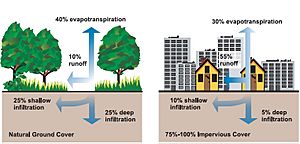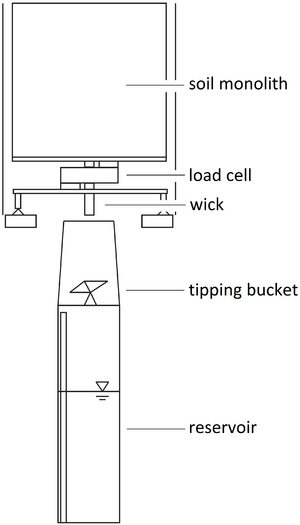Evapotranspiration facts for kids

Evapotranspiration (say: ee-vap-oh-tran-spuh-RAY-shun), or ET for short, is how water moves from the Earth's surface into the air. It's a combination of two main things:
- Evaporation: This is when water turns into vapor and goes directly into the air from places like soil, lakes, rivers, and even wet leaves.
- Transpiration: This is when plants release water vapor into the air through tiny openings in their leaves, called stomata. It's like plants "sweating."
Evapotranspiration is a super important part of the water cycle and affects our climate. Knowing how much water moves this way helps people manage water for things like farming.
Contents
What is Evapotranspiration?
Evapotranspiration is simply the total amount of water that goes from the Earth's surface into the atmosphere. This includes water from open water (like oceans and lakes), ice, bare soil, and all kinds of plants.
Scientists measure evapotranspiration to understand how much water crops need, when to water fields, and how to manage water in different areas.
- Evaporation: This is when water changes from a liquid to a gas (vapor) and rises into the air. It happens from wet surfaces like soil, puddles, and bodies of water. Things like heat, sunlight, wind, and how much moisture is already in the air can affect how fast water evaporates.
- Transpiration: This is the process where plants take in water through their roots. The water then travels up through the plant and exits as vapor through tiny holes in their leaves called stomata. How much a plant transpires depends on the type of plant, the soil, the weather, and how much water is available.
Evapotranspiration is usually measured in millimeters of water. This tells us how much water moves from a certain area into the air over a specific time. Globally, it's thought that about 60% to 75% of the rain that falls on land goes back into the atmosphere through evapotranspiration.
What Affects Evapotranspiration?
Many things can change how much evapotranspiration happens in an area.
Main Factors
The three main things that control evapotranspiration are:
- Water availability: How much water is actually there on the ground or in the plants. If there's no water, there can't be any evapotranspiration.
- Energy (heat): The amount of heat in the air and soil. More heat means more energy for water to turn into vapor. Climate change has made global temperatures higher, which has increased evapotranspiration over land.
- Air's ability to hold water: How much moisture the air can still take in. If the air is already very humid, it can't take much more water.
Other Important Factors
Plant Type
The kind of plants in an area affects evapotranspiration.
- Smaller plants, like herbaceous plants (think grass or flowers), usually transpire less than woody plants (like trees and bushes). This is because woody plants often have more leaves.
- Plants with deep roots can pull water from deeper in the soil. This means they can keep transpiring even when the surface soil is dry.
- Conifer forests (like pine trees) often have higher rates of evapotranspiration than deciduous broadleaf forests (trees that lose their leaves). This is especially true in winter and early spring because conifers are evergreen and keep their leaves all year.
Plant Coverage
If an area has a lot of plants, like a dense forest, transpiration becomes a bigger part of evapotranspiration compared to simple evaporation from the soil.
- More plants can mean more evapotranspiration, which might reduce the amount of water that flows into rivers and streams.
There are some special cases:
- Cloud forests: In these forests, trees collect water directly from fog and low clouds. They still transpire, but they often collect more water than they release.
- Rainforests: These dense forests actually help increase rainfall. The high evapotranspiration in rainforests adds a lot of moisture to the air. This moisture then condenses and falls back as rain. The dense trees also block sunlight and wind, which reduces water loss from the ground. When rainforests are cut down, the ground gets hotter and windier, soil moisture drops, and the area can turn into a desert.
Soil and Watering
In places that aren't watered by people, the actual evapotranspiration is usually not more than the rainfall. It's often less because some water soaks deep into the ground (percolation) or runs off the surface.
- An exception is areas with a high water table (where groundwater is close to the surface). Here, water can rise up through the soil to the surface.
- If the potential evapotranspiration (how much water could evaporate and transpire) is more than the actual rainfall, the soil will dry out. This is unless irrigation (watering by people) is used.
How is Evapotranspiration Measured?
Direct Measurement
One way to measure evapotranspiration directly is with a special tool called a lysimeter.
- A lysimeter is like a giant scale that continuously weighs a section of soil with plants in it. It also measures any water added by rain or irrigation.
- By tracking the changes in weight, scientists can figure out how much water has left the soil and plants through evapotranspiration. This method is very accurate for small areas.
Indirect Estimation
It's often hard to measure evapotranspiration directly over large areas. So, scientists usually estimate it using other methods.
Water Balance Method
One way to estimate evapotranspiration is by looking at the "water balance" of an area. This method uses a simple equation:
- The change in water stored in an area equals the water coming in (like rain) minus the water leaving (like evapotranspiration, river flow, and water soaking into the ground).
- If you know the other numbers, you can figure out the evapotranspiration.
Energy Balance Method
Another way to estimate evapotranspiration is by looking at the energy balance. This method uses the idea that energy is needed to turn liquid water into vapor.
- Scientists measure how much energy is coming in (from the sun) and how much is being used for other things (like heating the soil or the air).
- The energy left over is what's used for evapotranspiration. Special tools and even satellite images can help calculate this.
Using Weather Data
Scientists can also estimate evapotranspiration using weather information like wind speed, temperature, and humidity.
- There are different equations for this. The Penman–Monteith equation is one of the most common and is recommended by organizations like the Food and Agriculture Organization.
- These equations help calculate "reference ET," which is how much water a standard grass surface would lose.
- To get the actual evapotranspiration for a specific crop, scientists use "crop coefficients." These numbers adjust for the type of plant and how it grows throughout the year.
See also
 In Spanish: Evapotranspiración para niños
In Spanish: Evapotranspiración para niños
- Water cycle
- Effects of climate change on the water cycle
- Irrigation
- Water resource management
- Hydrology (agriculture)




